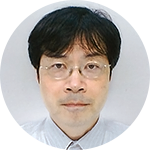Members
Tsuruyama, Tatsuaki
(April 1, 2016 ~ March 31, 2020)
Greeting
I am in charge of drug discovery pathology. Pathology is one of the medical and life science fields for understanding the cause and pathogenesis of a disease through morphological observations using microscopes. I have been teaching pathology at Kyoto University for over 20 years, and I primarily support pathological studies of mouse and human samples at the center for anatomical, forensic, and pathological research in the graduate school of medicine.
Our graduate school supports about ten educational courses (The Graduate Courses of Integrated Research Training).I take part in one of them, a pathology and pathophysiology course that is the only one of its kind in the whole world. Graduate students can also take a training course in mouse histology and anatomy. Furthermore, we are preparing a drug discovery course in which a unique textbook will be used for the special curriculum organized for students who will learn the basics of pathology for drug discovery through lectures and practical training.
We look forward to your participation!
Drug discovery medicine and pathology
We are studying the combination of various image analytical techniques such as atomic force/electron/mass spectrometry microscope and proteomics analysis. In mass spectrometry imaging (left picture), the histone H2A signal was intensely observed in cancer cells surrounded by red lines (right picture). By directly identifying the protein characteristics of diseases, we are aiming to identify a set of proteins that cause disease for the search of biomarkers and to identify target molecules for therapeutic drugs. This new technology is expected to become indispensable for pathology and pharmacokinetics, pharmacology, and the analysis of drug responses in the future.
Tissue research project
(MEXT Special Expense Project)
For drug discovery research, it is essential to secure high-quality research samples. We are conducting our Tissue Research Project on storage technology. Through this project, we promote drug discovery medicine with private-enterprise pharmaceutical companies by sharing top-quality samples. Please contact us if you are interested in collaborative research for the discovery of biomarkers.
Room 306, Center for Anatomical, Pathological and Forensic Medical Researches,
Graduate School of Medicine, Kyoto University
Yoshida Konoe-cho, Sakyo-ku, Kyoto 606-8501, Japan
TEL: +81-75-753-4483/4427
EMAIL: tsuruyam@kuhp.kyoto-u.ac.jp

- Tsuruyama T, et al. Constitutive activation of Stat5a by retrovirus integration in early pre-B lymphomas of SL/Kh strain mice. Proc Natl Acad Sci U S A. 99(12): 8253-8, 2002.
- Kakimoto Y, Tsuruyama T et al. Sorbin and SH3 domain-containing protein 2 is released from infarcted heart in the very early phase: proteomic analysis of cardiac tissues from patients. J Am Heart Assoc. 2013;2(6):e000565.
- Hiratsuka T, Tsuruyama T, et al. ZFP521 contributes to pre-B-cell lymphomagenesis through modulation of the pre-B-cell receptor signaling pathway. Oncogene. 2016 (in press).

